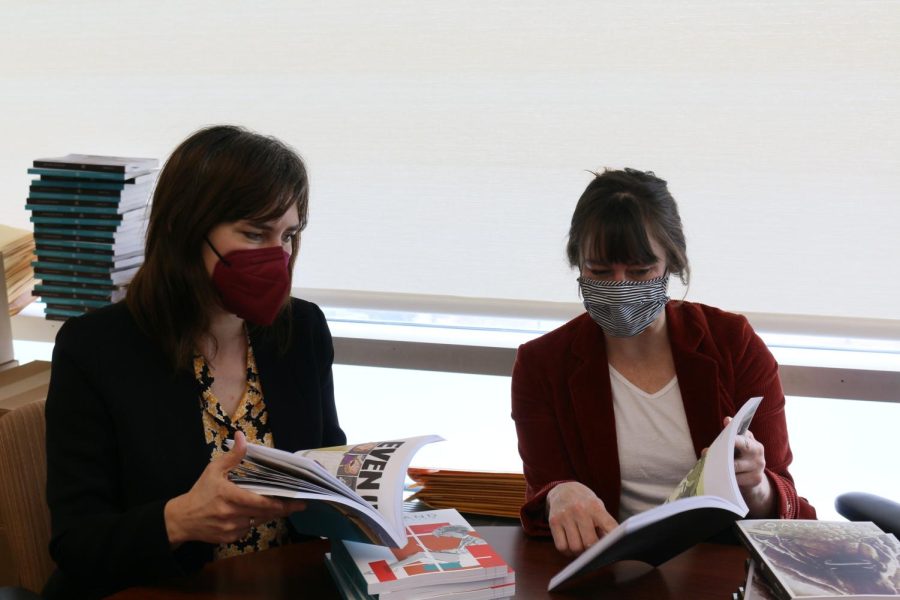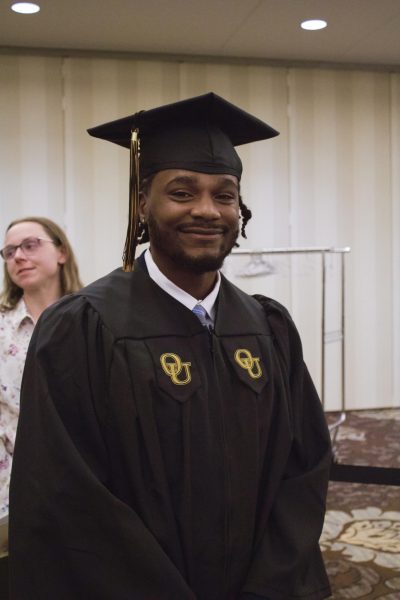The people behind The Oakland Arts Review: OU’s international undergrad literary arts journal
Professor Susan McCarty (left) and Professor Alison Powell (right) admiring some of the art in recent volumes of The Oakland Arts Review.
Now in its seventh volume, OU’s international undergraduate literary arts journal The Oakland Arts Review (OAR) is still chugging along — giving students professional publishing and editing experience and connecting the university to the broader world of contemporary literature.
With the average lifespan of literary journals being one to three issues, OAR has persevered in a crowded market space by diligently pursuing and publishing quality poetry, fiction, nonfiction and visual art from undergraduate students around the globe.
The inception of the journal which is now synonymous with OU’s Creative Writing program, came following a discussion between Professor Alison Powell and then-Creative Writing Program Director Annie Gilson.
“I was talking with Professor Gilson about what kinds of activities I might want to do outside of teaching and my own writing,” Powell said. “… I told her that I had this idea of doing an undergraduate literary magazine, but not one just for Oakland, it would be one that had a national focus. She was like, ‘I think that’s great.’ And then we started from there.”
With that green light from leadership in the Creative Writing program, Powell began recruiting students to help her form OAR’s original incarnation as a student organization. That editorial group started putting things together in 2015, and laid much of the groundwork that allows the journal to operate successfully today.
“I had a student at the time, Lindsay Olson, who was a creative writing major, an amazing nonfiction writer, and it was really her,” Powell said. “She put in a huge amount of work and effort … We had a core group of like six students … Had no idea what we were doing and it was really inefficient, but we managed to crank out the first issue.”
With that initial success and thrill of putting together the early issues, eventually it was decided that OAR would be better suited as something incorporated directly into the Creative Writing program’s course offerings.
“It became clear that the project was going to be too much to sustain just on extra hours here and there,” Powell said. “… We realized that what would really work would be if a faculty member taught the class … It ended up working really well and made me wonder why there aren’t more classes like this in English departments because so many students are really interested in literary editing and publishing.”
One student who took advantage of the opportunities the journal provides is current Managing Editor of OAR Malaena Caldwell. A double major in French Language and Literature and Creative Writing with a specialization in nonfiction, Caldwell is one of the brightest and hardest-working students in OU’s class of 2022. A conversation with Gilson convinced her that OAR was the right fit for her.
“I was excited for the class [and] getting that experience under my belt for hopefully an internship down the line,” Caldwell said. “I just got into grad school where they have a literary journal. And so it’ll be nice to have that [OAR] experience going forward.”
Caldwell is currently a semi-finalist for the Fulbright Scholarship and will continue her education by first going to France to teach and then heading to Oklahoma State University to pursue a Master of Fine Arts degree studying creative non-fiction. As she leaves OU, Caldwell reflects fondly on her time working to produce OAR.
“It’s organized chaos,” Caldwell said. “… The whole process of talking to the authors, emailing them and then getting their work … I love that process. It was a lot of fun reading through everyone’s pieces. It helped me gain a scope of where other artists are at [creatively] during this time … It was a different kind of experience to talk about art that wasn’t necessarily published and I value that.”
Every issue of OAR has been curated by a team of students and faculty. A professor teaches the course and serves as the de facto editor-in-chief, leading editorial meetings and structuring the course to inform students about editing and the publishing process. Students who take the course are assigned editorial responsibilities and get to vote for creative pieces they think are the best fit for that volume of OAR.
Powell has been a constant presence since the beginning of OAR as either the faculty member leading the journal, or as an adviser in charge of page design. Creative Writing Program Director Jeff Chapman and Professor Susan McCarty have also served as the faculty member leading the journal.
McCarty is the current faculty member leading the journal. She sees OAR as not only providing valuable professional experience for students, but also as creating space for the current generation of undergraduate artists to make their voices heard.
“As a writer, it’s a way of establishing those communities,” McCarty said. “Sometimes young writers are working, they feel isolated and they’re working alone. Being accepted into a journal and being published is a way for them to not be alone anymore. It’s a way for them to be in a space of other like minded people … It’s really important for students to have these special places where they can express what matters to them, what they’re scared of, what their anxieties are. This generation has a weight on them … They have responsibilities and problems that I think are unparalleled. For them to have a journal to express those fears and those anxieties is really important.”
Outside of what OAR provides for students at OU and elsewhere, having a well-curated and professionally-produced literary arts journal also sets Oakland University apart from other public universities around the country.
“There’s this whole community of literary journals out there,” McCarty said. “… There are coalitions of writers and readers everywhere and Oakland Arts Review puts [OU] into that conversation where contemporary writing is made … It makes Oakland University visible in the space of contemporary literature in a way that we otherwise wouldn’t be.”
Going forward the biggest threat to the longevity of OAR is going to be procuring funding for students and faculty to continue producing the journal. Given the financial measures the university is taking in reaction to the drop in enrollment caused by COVID-19, there’s a chance that the 2022-2023 school year could be the last for OU’s international undergraduate literary arts journal.
Heading into next year, Powell will be back at the helm as the faculty leader of the journal. After seven years of faculty and students successfully fine tuning the infrastructure and procedures of OAR, she sees now as the perfect time for university leadership to commit to making the journal a more permanent feature of OU.
“I think it would be really smart for the university to continue to fund this journal and to stop requiring annual requests from the faculty,” Powell said. “If they could make a commitment to fund it annually, then we can just continue to do it. We can focus our energy not on trying to scrape up funds, but on advertising the journal and getting better submissions … It seems really short sighted if the university were to let [OAR] fail.”
Editor’s note: For full transparency, Jeff Thomas is a former Poetry Editor of The Oakland Arts Review.











